Physical Address
304 North Cardinal St.
Dorchester Center, MA 02124
Chemical injuries are true ophthalmic emergencies.
Treatment should commence immediately—detailed history can wait.
Copious irrigation with a neutral solution is primary treatment.
Delayed treatment may result in penetration of chemical to anterior chamber.
Remove particulate matter during irrigation.
pH should be checked regularly and continued after irrigation ceases.
Strong acids and alkalis are equally destructive.
Medical treatment should include antibiotics, corticosteroids, citrate, and ascorbate.
Long-term sequelae may lead to blindness.
Rehabilitative surgery should be delayed until inflammation subsides.
Eyelid and forniceal abnormalities should be addressed prior to rehabilitation of the ocular surface.
Remember to monitor for glaucoma.
We thank Dr. Jay J. Meyer, MD (University of Auckland) for his significant contribution to the previous version of this chapter. All clinical photographs are courtesy of the authors of this chapter, with the exception of Fig. 95.1 kindly provided by Dr. Sue L. Ormonde, MD, FRCOphth, and Fig. 95.6 kindly provided by Dr. Chi-Ying Chou, MBChB (University of Auckland Department of Ophthalmology, New Zealand).
Ocular chemical injuries are true ophthalmic emergencies due to the potential for permanent visual impairment or even blindness. Where strong alkalis and acids are involved, significant exposure results in severe injury to the ocular surface, adnexa, and intraocular structures. In these cases, the visual prognosis is poor, and functional (or physical) loss of the eye is not uncommon. Insult to the limbal environment and resident stem cell population impairs the regenerative capacity of the cornea resulting in chronic ocular surface disease and portends a poor prognosis for visual rehabilitation with traditional keratoplasty. Cicatrization of the ocular adnexa, intractable glaucoma, cataract formation, and retinal and optic nerve damage may further limit visual potential. The visual rehabilitation of severe ocular chemical burns is complex and typically protracted over many years with multiple interdisciplinary surgeries.
Over the last two decades, the prognosis of these severe ocular burns has improved, partly due to emphasis on eye protection in the workplace, but also due to significant advances in our understanding of the corneal and ocular surface inflammatory and healing response, together with more targeted medical and surgical management. Although the final visual outcome is strongly related to the severity and nature of the initial chemical exposure, the prognosis is heavily influenced by the timing of appropriate treatment.
Worldwide, an estimated 107,000 people are blinded each year by ocular chemical injury. The frequency and distribution vary by geographic region and are purported to be higher and more severe in developing countries compared with highly developed countries.
Fortunately, the majority of chemical eye injuries are classified as mild, and severe chemical injuries are relatively rare, with a reported incidence ranging between 0.02 and 1.58 per 100,000. , Bilateral injury occurs in about a quarter of victims. , The archetypical burn victim is classically a young male industrial worker ; however, a recent large epidemiologic survey from the United States reported that age-specific injuries were the highest among children aged 1–2 years. The same study also reported gender equivalency and identified individuals in the first and second lower income quartiles as being at the greatest risk of chemical injury.
Chemical burns can occur in a wide range of scenarios, including domestic, agricultural, industrial, and, much less commonly, assault. , , Ultimately, as many victims are young, working individuals, ocular burns can have a profound economic and psychologic impact on the injured and their families.
Acids and alkalis are the agents most commonly associated with significant chemical eye injuries. The severity of the injury depends on a number of factors including: (1) concentration and pH of the solution, (2) the extent of ocular surface exposure, and (3) the duration of ocular exposure before treatment is instigated. These injuries can be further compounded by foreign material, for example, concrete debris (high-power pumps; Fig. 95.1 ), metal fragments (fireworks and car batteries), or plant material (agricultural injuries). Therefore any history of high velocity or explosive events makes the exclusion of forniceal, subconjunctival, or intraocular foreign bodies mandatory. Further details of the acids and alkalis commonly associated with ocular injuries are highlighted in Tables 95.1 and 95.2 .
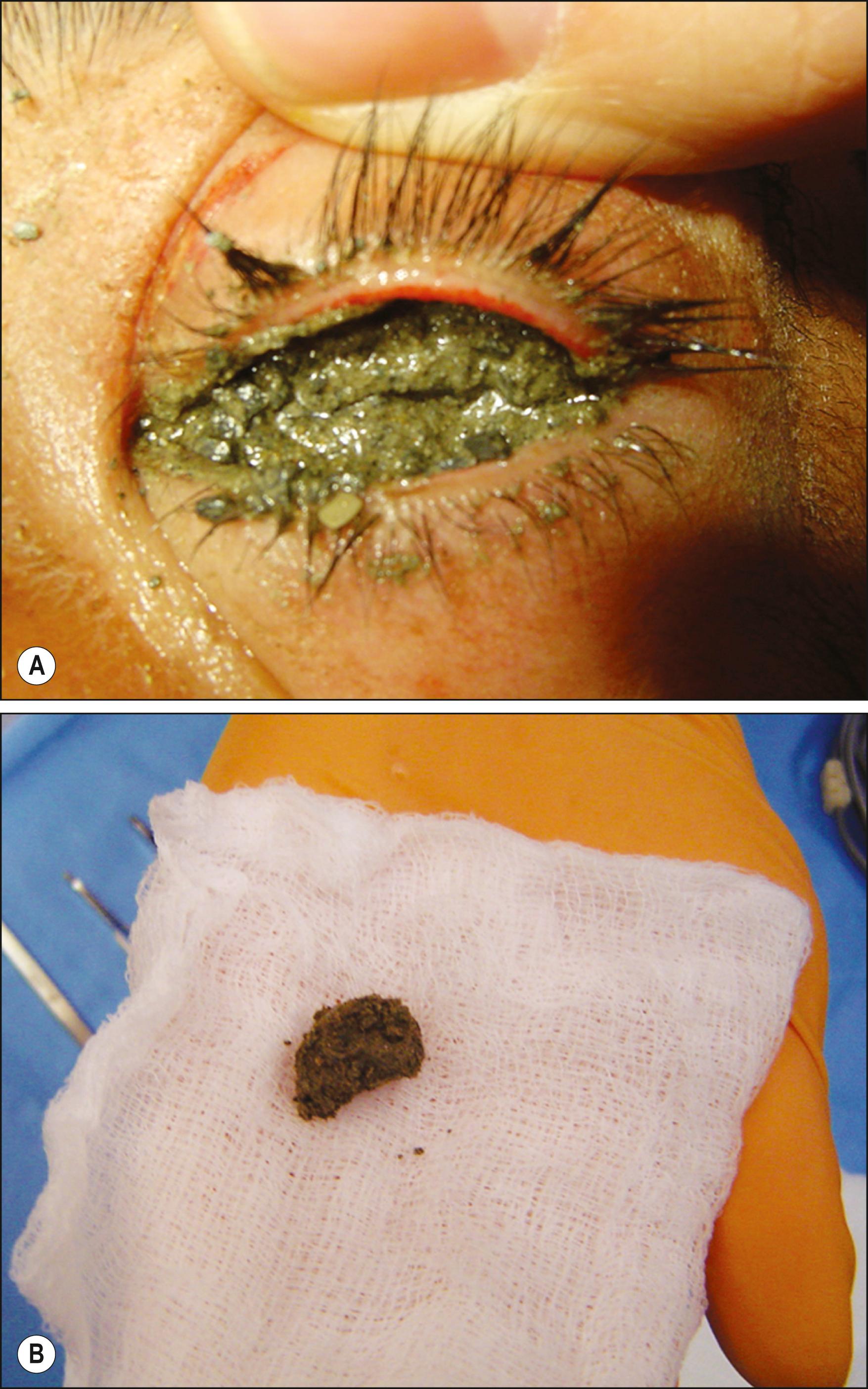
| Common Alkalis | pH of 0.1 M Solution | Sources/Uses | Comments |
|---|---|---|---|
| Ammonium hydroxide (NH 3 ) | 11.1 | Fertilizers, refrigerants, cleaning agents | Rapid penetration |
| Sodium Hydroxide (NaOH)—Lye | 13 | Caustic soda, drain cleaner, manufacture of pulp, paper, textiles and soaps | Rapid penetration |
| Potassium hydroxide (KOH) | 12 | Caustic potash | Dissolution in water strongly exothermic. Corrosive |
| Magnesium Hydroxide (Mg [OH] 2 ) | 10.5 | Fireworks | Combined chemical and thermal injury |
| Calcium hydroxide (Ca[OH] 2 )—Lime | 12.4 | Cement, plaster, whitewash, industrial cleaners | Often found in composite mixtures. Poor penetration. Retained particulate matter provides sump for ongoing toxicity |
| Common Acids | pH of 0.1 M Solution | Sources/Uses | Comments |
|---|---|---|---|
| Sulfuric (H 2 SO 4 ) | 1.2 | Battery acid, industrial cleaners | Diprotic acid |
| Sulfurous (H 2 SO 3 ) | 1.5 | Fruit and vegetable preservatives, bleach, refrigerants | Good penetration |
| Hydrofluoric (HF) | 2.1 | Mineral refining and production, glass polishing and frosting, gasoline alkylation | Severe injury due to rapid penetration and chelation of calcium and magnesium ion |
| Acetic (CH 3 COOH) | 2.9 | Vinegar | Classified as a weak acid but corrosive in concentrated form |
| Hydrochloric (HCL) | 1.1 | Gastric acid, household cleaning, plastics production | Stable on storage |
| Chromic (H 2 CrO 4 ) | 1 | Chrome plating | Diprotic acid |
Alkalis readily penetrate the eye as the hydroxyl ion (OH) saponifies plasma membranes resulting in cell disruption and death. Changes in aqueous humor pH are observed within a few seconds of contact with ammonium hydroxide and within 3–5 minutes after sodium hydroxide injury. , By contrast, the vitreous has been shown to maintain its physiologic pH, even in the presence of anterior chamber pH elevation; an ability attributed to the buffering capacity of the crystalline lens and the iris. Therefore the diffusion of proinflammatory cytokines is proposed as the mechanism of retinal damage rather than the direct effect of alkali on the retina.
In general, acids penetrate the corneal stroma much less readily than alkalis as they induce precipitation of the epithelial proteins, which then form a barrier against further chemical ingress. However, if an acid succeeds in penetrating the stroma, the damage to ocular structures is similar to that observed in alkali injury. Indeed, studies have shown no clinically significant differences in clinical course and prognosis between severe acid and alkali burns.
A summary of potential sequelae of ophthalmic chemical burns is provided in Table 95.3 . Figs. 95.2–95.4 highlight some of the complications of chemical burns.
| Lids |
|
| Ocular surface |
|
| Elevated intraocular pressure | Secondary glaucoma |
| Intraocular structures |
|

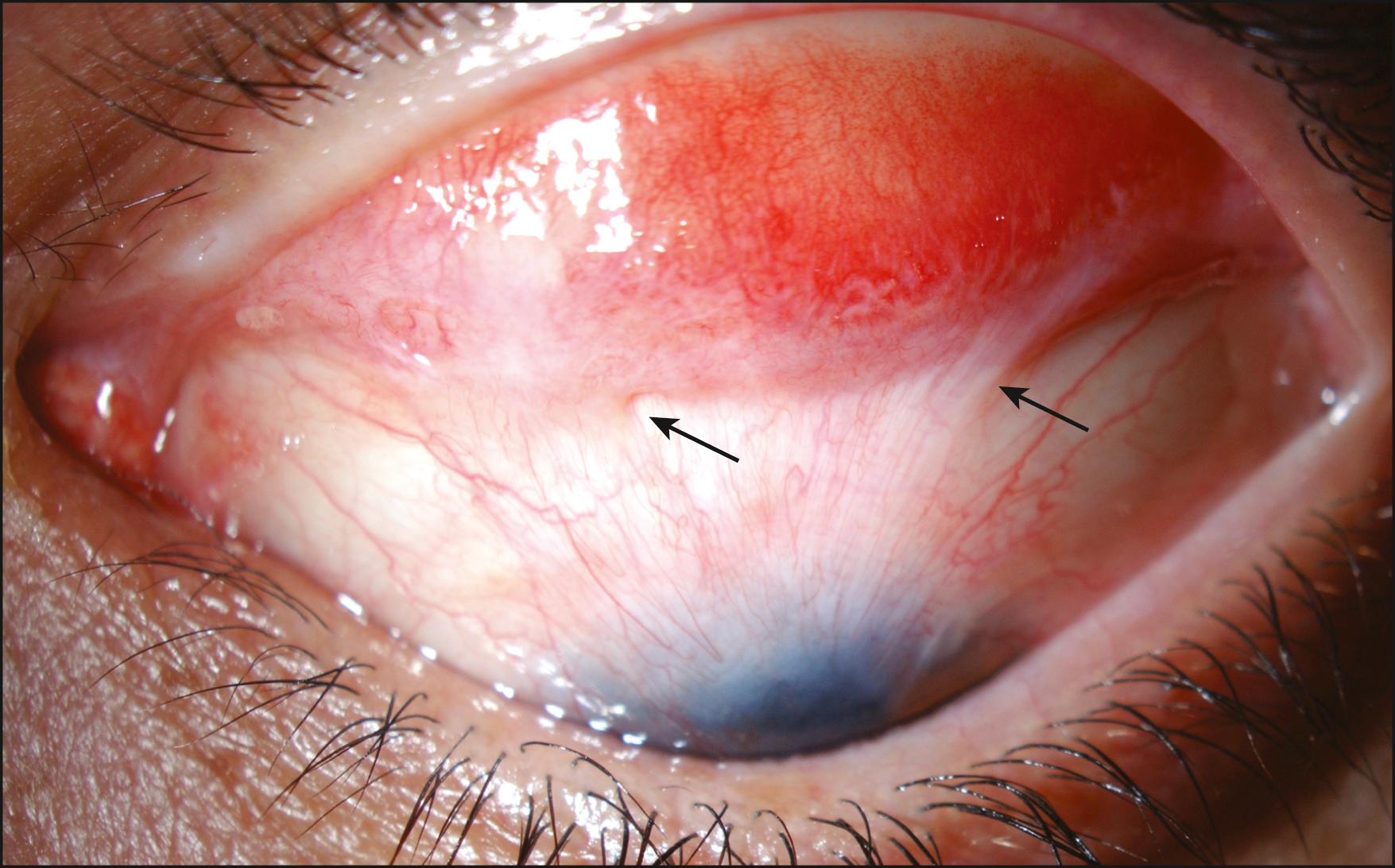
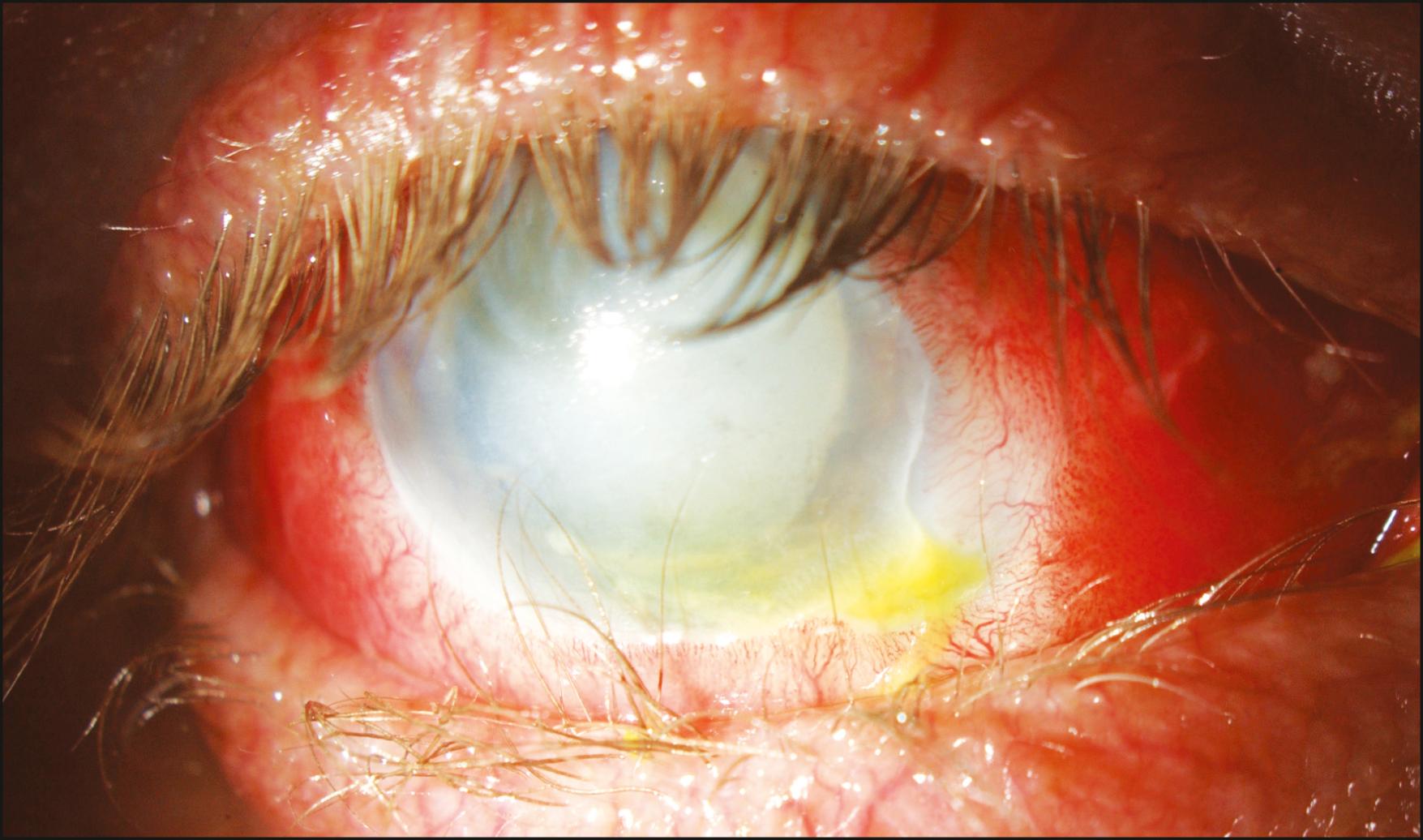
Early assessment should include careful documentation of the extent and severity of corneal, limbal, and conjunctival involvement as it provides an important reference tool in formulation of subsequent evaluation and management plans.
Classification schemes for grading the severity of the initial injury are useful in guiding treatment and provide an estimation of prognosis. The Roper–Hall classification system ( Table 95.4 ) was introduced in the mid-1960s and is the most established and commonly applied system. It provides prognostic guidelines based on the degree of corneal haze and the amount of perilimbal ischemia. However, there have been changes in the understanding and management of ocular surface injuries in the years since the introduction of the Roper–Hall classification. In particular, there has been an enhanced understanding and appreciation of the role of the limbus in wound healing. In order to reflect these changes, Dua proposed a new classification scheme in 2001 ( Table 95.5 ) based upon clock hours of limbal involvement (as opposed to ischemia) as well as the percentage of conjunctival involvement. The Dua classification has been shown to have superior prognostic value over the Roper–Hall classification scheme in the context of severe ocular burns.
| Grade | Prognosis | Corneal Appearance | Limbal Ischemia |
|---|---|---|---|
| I | Good | Epithelial damage | None |
| II | Good | Haze but iris details visible | <1⁄3 |
| III | Guarded | Total epithelial loss with haze that obscures iris detail | 1⁄3–½ |
| IV | Poor | Cornea opaque with iris and pupil obscured | >½ |
| Grade | Prognosis | Clock Hours of Limbal Involvement | Conjunctival Involvement (%) | Analog Scale ∗ |
|---|---|---|---|---|
| I | Very good | 0 | 0 | 0/0% |
| II | Good | ≤3 | <30 | 0.1–3/1%–29.9% |
| III | Good | >3–6 | >30–50 | 3.1%–6%/31%–50% |
| IV | Good to guarded | >6–9 | >50–75 | 6.1–9/51%–75% |
| V | Guarded to poor | >9–<12 | 75–<100 | 9.1–11.9/75.1%–99.9% |
| VI | Very poor | 12 | 100 | 12/100% |
∗ The analog scale records accurately the limbal involvement in clock hours of affected limbus/percentage of conjunctival involvement. While calculating percentage of conjunctival involvement, only involvement of bulbar conjunctiva, up to and including the conjunctival fornices, is considered.
Examples of mild, moderate, and severe chemical burns are highlighted in Figs. 95.5–95.7 , respectively.
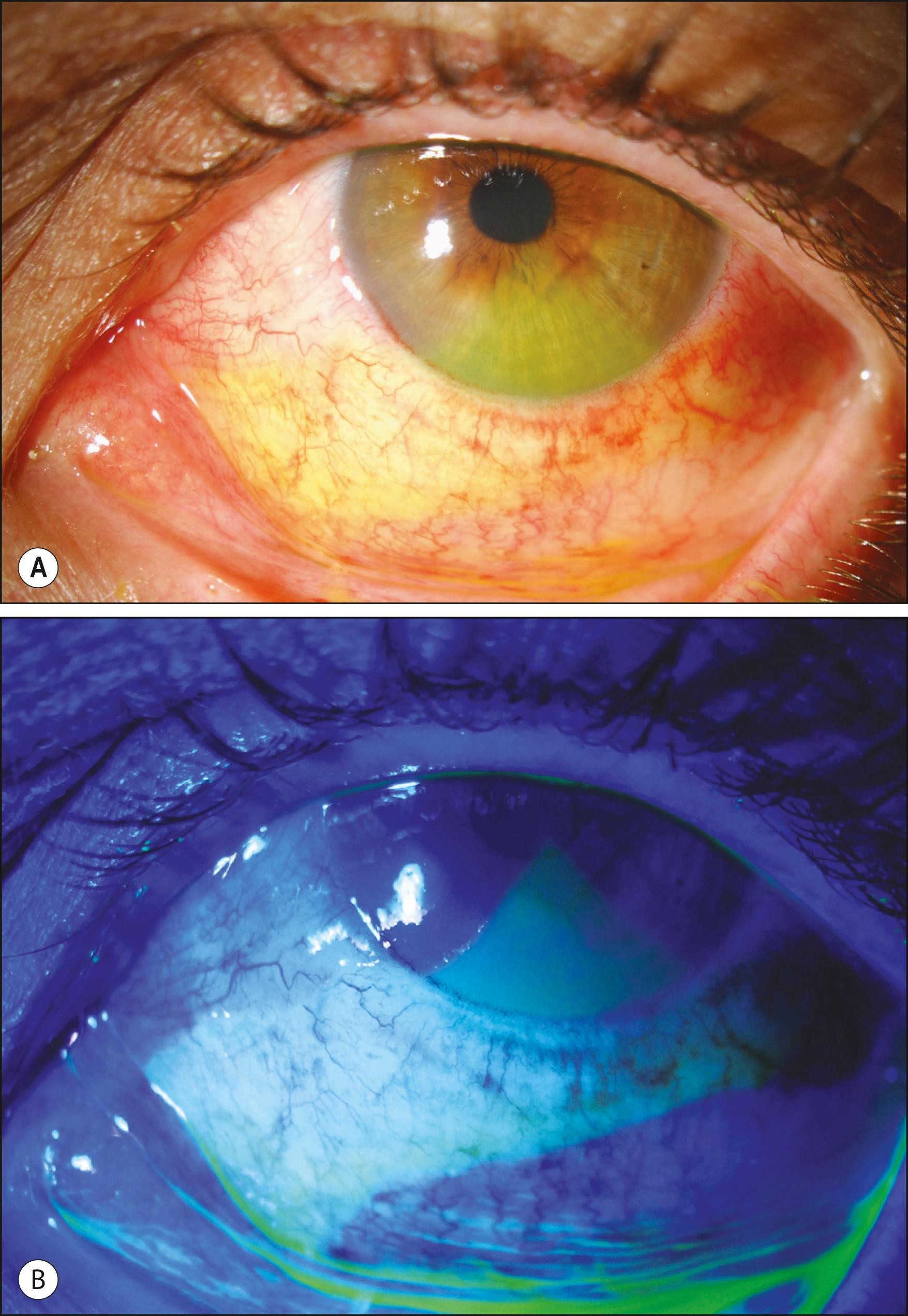
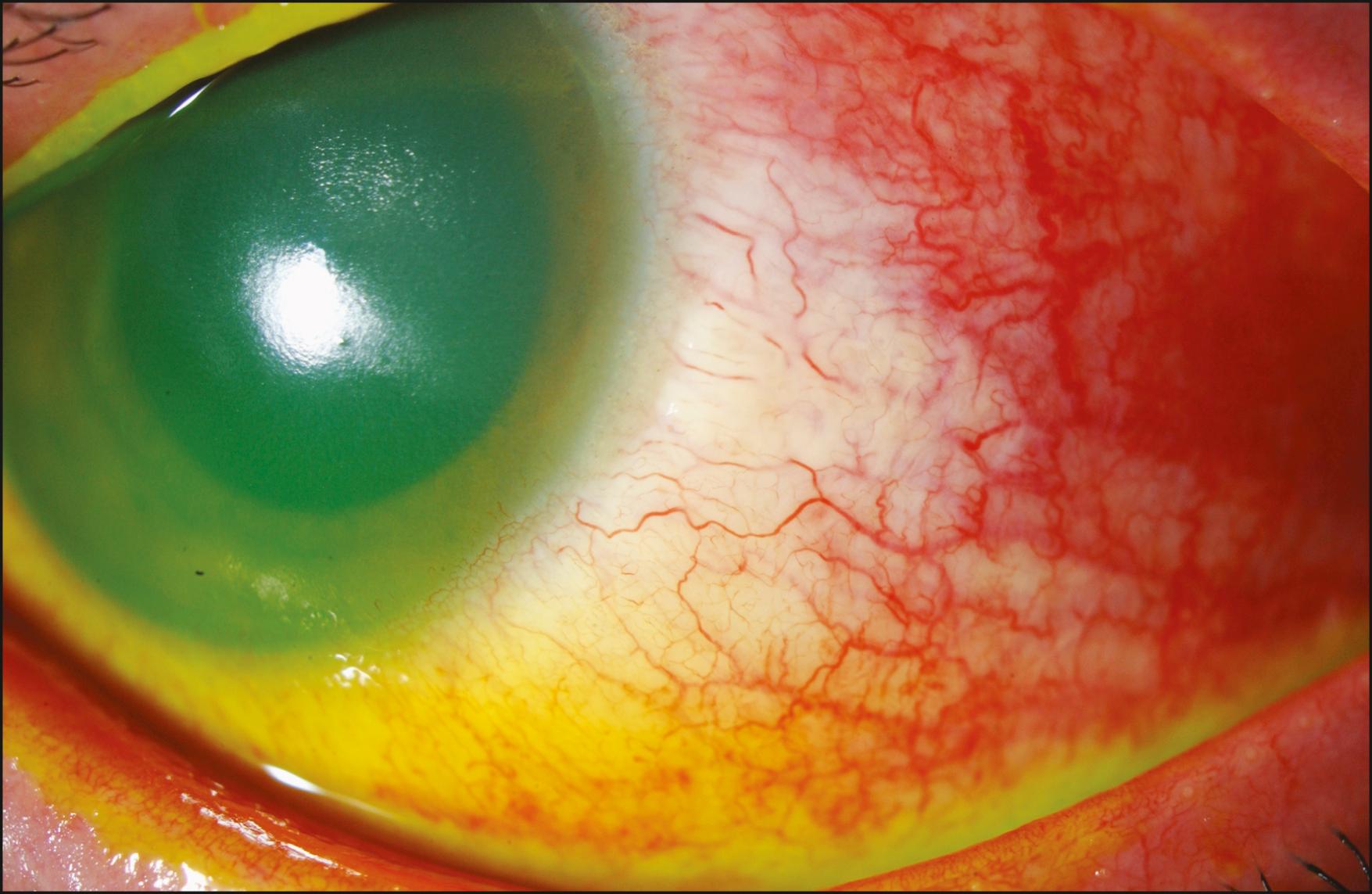
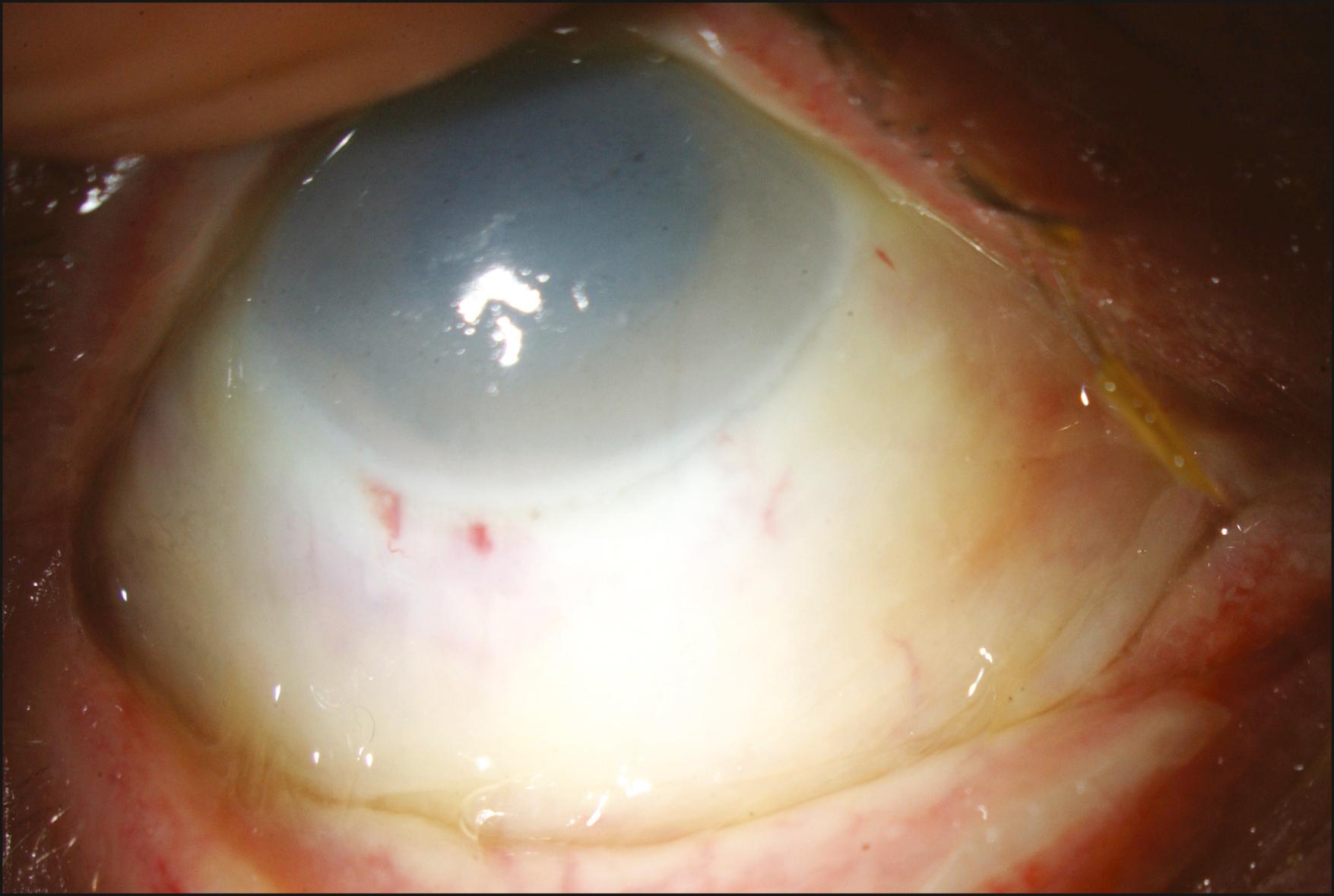
Initial emergency management involves prompt irrigation and the removal of residual chemical debris from the eye. The objectives are to minimize the ingress of the chemical agent into the anterior chamber and to remove a potential reservoir for ongoing injury. The most important intervention to reduce the severity of the injury is immediate copious irrigation. Irrigation should be continued until pH neutralization is achieved. The pH of both eyes should be tested, even in cases of apparent unilateral injury, to avoid unrecognized injury. External irrigation for 90 minutes reduces the pH by 1.5 units according to animal models. Although there may be an advantage to using amphoteric buffering solutions, urgency may necessitate the use of any available neutral irrigation fluid.
Eversion of the eyelids (sometimes double eversion) is required for complete inspection and cleaning of the fornices, which may harbor retained particles or foreign bodies. It is imperative to remove all particulate matter as it may continue to cause chemical injury after the initial insult. In some severe cases, sedation or general anesthesia may be necessary to examine the patient effectively and remove particulate matter.
External irrigation is of limited value in eliminating chemicals once they have reached the intraocular chambers. Animal models of alkali injuries have shown that a paracentesis lowers the aqueous humor pH by 1.5 pH units, and subsequent anterior chamber reformation with buffered phosphate solution can lower the aqueous pH by a further 1.5 pH units. However, this approach is not part of contemporary routine practice, and the value of paracentesis and anterior chamber irrigation in chemical injury remains controversial.
The acute management of ocular chemical burns is targeted toward the control of inflammation, prevention of stromal breakdown, promotion of reepithelialization and repair, and prevention of complications.
A retrospective study of patients with alkali burns showed that intensive therapy with a combination of topical corticosteroids, antibiotics, ascorbate and citrate, atropine, and oral vitamin C was most effective in the treatment of patients with Roper–Hall Grade III injuries (with reference to time to reepithelialization and visual acuity). Conversely, intensive therapy delayed reepithelialization in the context of grade I and II injuries, presumably as a result of drug toxicity and inhibition of reepithelialization by corticosteroid.
There is a lingering controversy regarding the use and timing of topical corticosteroids in the treatment of chemical burns. While corticosteroids have the advantageous effects of inflammatory cell suppression and collagenase inhibition, they also suppress keratocyte migration and collagen production and therefore may cause corneal thinning.
Sterile ulceration occurs when there is an imbalance between collagen synthesis and proteolytic degradation. Consequently, the risk of sterile ulceration in the first week following a chemical injury is relatively modest but increases as the corneal repair process becomes established at about day 14 postinjury. Experimental models have demonstrated that the use of corticosteroids in the first 10 days postinjury does not appear to have an adverse effect on outcome. An early animal study by Donshik et al. observed that the prolonged use of topical corticosteroids was associated with an increase in the incidence and severity of corneal ulceration. More recent studies have suggested that the corneal ulceration observed in Donshik et al.’s study with longer duration topical corticosteroids may have actually been a product of the prolonged scorbutic state of the aqueous humor rather than a direct action of topical steroids per se . Subsequently, Davis et al. and Brodovsky et al. concluded that the prolonged use of topical steroids is not associated with corneoscleral melting when used in conjunction with topical ascorbate.
The efficacy of tetracyclines in reducing collagenase activity and corneal ulceration has been demonstrated in experimental alkali injuries. , This action is independent of their antimicrobial properties and is thought to occur through multiple mechanisms, including inhibition of gene expression of neutrophil collagenase, inhibition of [α] 1 -antitrypsin degradation, and scavenging of reactive oxygen species. An additional mechanism is through the chelation of zinc—an element indispensable to the activity of matrix metalloproteinases. , Animal studies have shown that topical treatment with doxycycline can also reduce the incidence and extent of corneal neovascularization if given prior to the appearance of this delayed pathology.
Oral tetracycline 250 mg four times per day; doxycycline 100 mg daily; or minocycline 100 mg twice per day can be given in combination with topical tetracycline preparations (1% suspension or 3% ointment).
Following a chemical injury, ascorbate levels in the aqueous humor may fall as a result of damage to the ciliary body epithelium. This scorbutic state has the potential to compromise stromal repair because ascorbate is a key cofactor in collagen synthesis. Topical or systemic supplementation of depleted aqueous ascorbate levels has been demonstrated to reduce the incidence of corneal thinning and ulceration following experimental alkali injuries if an aqueous humor concentration of 15 mg/dL can be achieved. Therefore early supplementation is absolutely critical—because ascorbate has no demonstrable effect on the progression of ulceration once it has become established. Supplementation can be achieved through the hourly topical application of 10% sodium citrate eye drops and/or 1000 mg of oral ascorbic acid given four times a day. In severe injuries, topical administration is superior to systemic administration, presumably due to the reduced capacity of the ciliary body epithelium to concentrate ascorbate into the aqueous humor.
In contrast to ascorbate, citrate is effective in both preventing and retarding the progression of corneal ulcers. Citrate chelates extracellular calcium and diminishes the activity of polymorphonuclear leucocytes by reducing membrane and intracellular calcium levels. Citrate has been shown to reduce neutrophil infiltration by 63% in the early phase and 92% in the late phase following chemical injury and also has an inhibitory effect on collagenase. As is the case with ascorbate, the topical application route is superior to the systemic route, and a 10% solution of citrate eye drops may be administered hourly.
Because citrate and ascorbate reduce corneal ulceration via different mechanisms, their combined use offers a decided therapeutic advantage over treatment with citrate alone. Typically, citrate has a greater effect than ascorbate on more severely injured eyes because of its inhibitory action on the inflammatory response. Severe chemical injuries may deplete collagen-producing fibroblast populations in the corneal stroma, thereby limiting the beneficial effect of ascorbate.
Become a Clinical Tree membership for Full access and enjoy Unlimited articles
If you are a member. Log in here